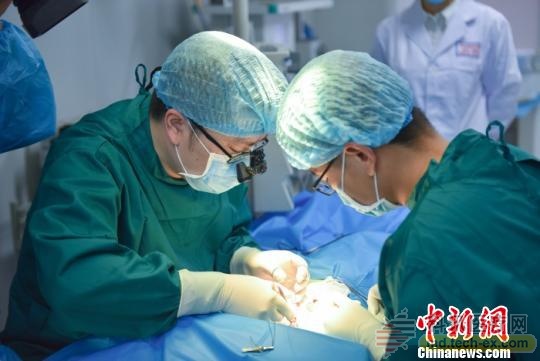The world's first 3D bio-printing blood vessels in China successfully tested in monkeys
Release date: 2016-12-13
" 3D bioprinting blood vessels constructed by stem cell bio-ink technology have been successfully implanted into rhesus monkeys to achieve angiogenesis." China's first batch of "Thousand Talents" experts, Sichuan Blu-ray Inno Biotech Co., Ltd. (hereinafter referred to as "Blu-ray Kang Yujian, chief scientist of the company, said that the achievement is the first in the world and is a milestone in the clinical application of stem cell technology.

Researchers implant replacement blood vessels. Photo by Dan Lin.
On the 11th, Blu-ray Inno was released in Chengdu, and the 3D bio-printing technology of the national “863†program jointly undertaken by the National Center for Regenerative Medicine of Sichuan University and the Bio-additive Manufacturing Industry Technology Research Institute of Sichuan Province promoted the research and development of artificial blood vessel endothelialization. A major breakthrough was made in the project – 3D bioprinting vascular animals were successful in vivo.
Kang Yujian introduced that the team he led took out about 5 grams of fat from the rhesus monkey body, extracted the adipose mesenchymal stem cells to make the "ink" required for 3D bioprinting, and then printed the blood vessels with special equipment and replaced the Approximately 2 cm of the abdominal aorta in the monkey. One month after surgery, the printed blood vessels have merged with the rhesus monkey's own abdominal aorta.
It is reported that since May 2016, 3D bioprinting vascular animal experiments have been officially started. As of December 1, 2016, Blu-ray Yingnuo has been implanted in 30 rhesus monkeys in vivo, and the survival rate of experimental animals is 100%. .
"The printed material is taken from the adipose-derived mesenchymal stem cells of the experimental animals, which guarantees the safety of the vascular graft in the body." Kang Yujian said that the traditional artificial blood vessels have endothelialization problems, which are prone to blockage and need to be replaced after about 10 years. . New technology solves this problem and prints blood vessels for life. In addition, patients with traditional artificial blood vessels need to use anticoagulants for life, and the printing of blood vessels shortens this time to 5 days after surgery, after which no medical treatment is needed.
It is reported that this technology will be used for the treatment of cardiovascular diseases. Studies have shown that the incidence of cardiovascular disease is the highest in the world. There are about 156 million people in the world and about 19 million people in China have artificial blood vessel transplants.
The Blu-ray development announcement said that in the next step, the company's 3D bioprinting blood vessels will apply to the relevant regulatory agencies for clinical trials.
"I have witnessed the development of each stage of this technology, and I have become full of expectations from the beginning." Xia Yingqi, the State Council Counselor and former deputy director of Beijing Zhongguancun Management Committee, praised this "Sichuan Technology". The development of scientific research and innovation is inseparable from the strength of the country. Since the reform and opening up, the state has sent many outstanding talents to study abroad. Now the contributions of this group of top talents to the society have been significant."
“Although there are similar studies abroad, this is the most mature one at the moment.†Professor Thomasson, director of the University of Tennessee Health Science Center, predicts that through clinical trials, technology is expected to be used on a large scale within five to ten years.
"It will be cheaper than it is now, and it is the stem cells of your body. There is no rejection." For the cost, Kang Yujian revealed that it is lower than the current artificial blood vessels.
Thomasson believes that the project offers the possibility of using 3D bio-printing technology in a wider range of medical fields. "The kidneys, liver and other human organs may be printed in the future."
In addition, Kang Yujian said that he is currently trying to print similar luminal materials: bile duct, ureter, fallopian tube, esophagus, and human organs such as liver and heart are also under development. "With this technology, it will also promote the regeneration of damaged organs in the human body. Organs will be repaired when they have problems."
“Printing out organs is not our goal. It is just a process of research and development.†At the press conference, Kang Yujian said that in the future, modern disease-based medical models will be changed to people-oriented health concepts, from standardized pharmaceutical processes to personalization. Health management turns the pharmaceutical industry into a health industry.
Source: China News Network
Olive Net Problems,Olive Net Packages,Olive Net Network,Olive Harvest Net
Changzhou Satidi Import and Export Co., Ltd. , https://www.czguanjiechuck.com